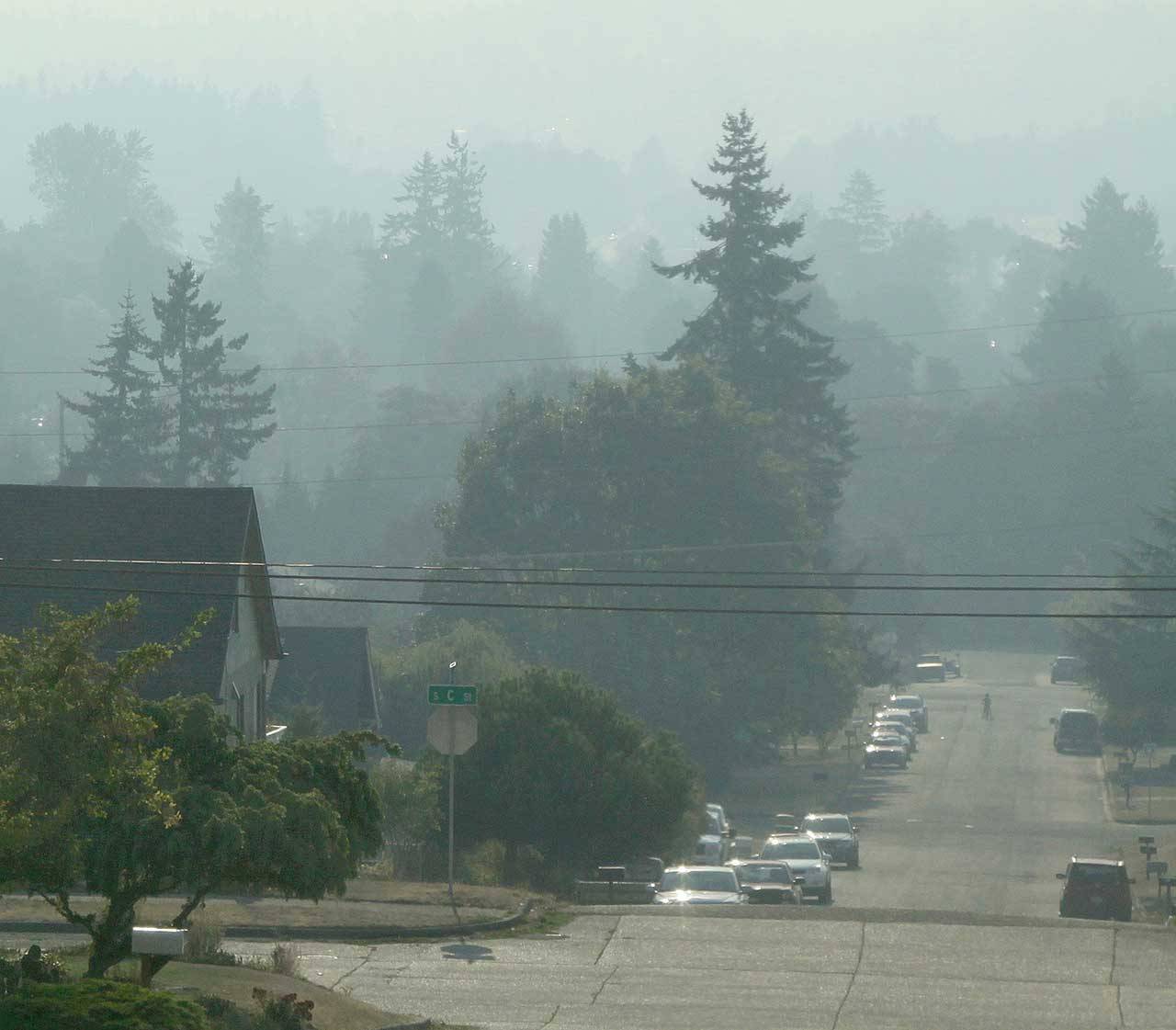Smoke from wildfires whipped by high winds in Eastern Washington on Monday blew into Western Washington overnight, plunging air quality into the very unhealthy or unhealthy range across the North Olympic Peninsula and blanketing the region in haze.
Monitoring stations across the North Olympic Peninsula posted air quality measurements of PM 2.5 (fine particulate matter of 2.5 microns or less) in Western Washington.
“Very unhealthy” air quality reached a high of 256 in pollution value at 8 a.m. Tuesday at Cheeka Peak south of Neah Bay, while Port Angeles reached a high of 228 in measurements taken by the state Department of Ecology’s Washington Air Monitoring Network at 10 a.m.
The Cheeka Peak air quality measurement had improved into the “Unhealthy” range with a reading of 152 by 4:30 p.m. Tuesday, as had the Port Angeles site, down to 164 by 4:30 p.m.
Port Townsend reached an air quality level of 191 by 8 a.m. Tuesday before values improved to 159 by midafternoon Tuesday.
Air quality values from 0-50 are considered good, 51-100 moderate, 101-150 unhealthy for sensitive groups, 151-200 unhealthy, 201-300 very unhealthy and 301 to 500 hazardous.
Under “Unhealthy” conditions, everyone — especially sensitive groups such those with heart, lung or other respiratory diseases, the elderly, and children and teens — should limit time spent outdoors, avoid strenuous activities outdoors and choose light indoor activities, the state said.
“Most of the smoke came from large fires that developed across Eastern Washington on Monday,” said Matthew Cullen, National Weather Service meteorologist.
“Later in the afternoon, the wind direction turned more from the east and smoke from the fires was carried over the Cascades and across the Puget Sound region. Smoke filled all the lowland valleys and was area wide [Tuesday] morning. There were some fires in Western Washington as well, but the big push of smoke was really transported across the Cascades,” he said.
More than 300,000 acres burned in Eastern Washington on Monday alone, according to Hilary Franz, state Commissioner of Public Lands.
“The pressure gradient got very strong across the Cascades and produced those high winds,” Cullen said.
“As wind is forced over the mountains, it gets compressed, and it produced very high pressure levels. Add in warming temperatures, and it led to the fires and smoke being transported west of the Cascades.”
The destruction of the raging fires in Eastern and Central Washington prompted Gov. Jay Inslee to compare it to a bomb going off.
Easterly winds were not expected to be as high going forward as they were Monday or Tuesday, but Cullen said the smoke-filled air could linger.
“In terms of fire danger, the potential will remain quite high,” Cullen said. “The winds won’t be quite as strong over the next few days, so the fires won’t be able to spread as much smoke. But there is increasing instability as temperatures will be increasingly warm for the next few days, and winds will be coming in an easterly direction.
“We do have some onshore flow forecast for Friday, and we are hoping that is able to clear out the smoke.”
Said the Puget Sound Clean Air Agency on its website at pscleanair.gov: “Variable winds continue to make it difficult to predict how long the smoke will last, but expect to see unhealthy and unhealthy for sensitive groups air quality at least through [today] and possibly beyond.”
The National Weather Service’s red flag warning in western Washington — including Hurricane Ridge and the eastern slopes of the Olympic Mountains — remains in effect through 11 p.m. Thursday due to warm, dry and windy conditions that could create extreme fire danger.
Clallam County, already under a burn ban through Oct. 1, modified its restrictions to “high” fire danger Tuesday, citing “reduced moisture levels, low humidity and warmer weather combined with the reduced availability of fire-fighting resources.”
The new restrictions allow camp fires within a concrete or metal fire pit of a maximum 3 feet in diameter and 2 feet in height in an approved campground or on private property, unless on Olympic National Park or Olympic National Forest lands, which are not regulated by the county.
The red flag warning prompted Jefferson County to implement a full ban on outdoor burning to include campfires and charcoal-burning barbecues.
Effective Monday, all outdoor burning, including recreational fires, fire pits and the use of charcoal briquettes was banned in the county. That includes outdoor barbecues such as Webers that use briquettes. Propane barbecues are still allowed.
To check air quality values, visit enviwa.ecology.wa.gov. or orcaa.org.
For more information, visit wasmoke.blogspot.com.
________
Sports reporter Michael Carman can be contacted at 360-406-0674 or at mcarman@peninsuladailynews.com.

